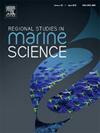盐田池塘水理化因子、浮游生物及凡纳滨对虾肠道生物组成
IF 2.4
4区 环境科学与生态学
Q3 ECOLOGY
引用次数: 0
摘要
盐田对虾养殖因其养殖的对虾品质优良而受到人们的重视。本研究选取盐度为33 ± 5 (HS33)、40 ± 5 (HS40)、47 ± 5 (HS47)和52 ± 7 (HS52)的4个盐田池塘,对5 - 9月各盐田池塘的水体物化因子、浮游生物和对虾(Penaeus vannamei)肠道食物生物组成进行分析。结果表明,水体中营养物峰值与浮游植物华度峰值存在时间差。总氮、总磷浓度先升高后降低,在7月达到峰值。浮游植物密度先上升后下降,在8月达到高峰。相反,各组浮游动物的密度随时间的推移先下降后上升,在6月份达到最低。调查期间,盐田池塘浮游植物以硅藻为主,桡足类和轮虫为主要浮游动物。盐田池塘的主要浮游植物不受培养时间的影响。7 ~ 9月浮游动物的平均体型减小,桡足类减少,轮虫增加。此外,盐田池塘浮游植物密度不受盐度梯度的影响,而浮游动物密度在33 ~ 47盐度范围内随盐度的增加而增加,在52盐度范围内下降。除8月份外,各盐田池塘对虾消耗的浮游生物以绿藻和桡足类为主,受盐度和培养时间的影响较小。这些结果表明,盐田塘浮游生物结构合理且相对稳定。浮游动物可能有选择性地进食,并作为绿藻进入虾肠的媒介。适当提高盐度(33 ~ 47)可以增加浮游动物的丰度,更适合虾类的生长。研究结果将为盐田对虾养殖的发展提供参考。本文章由计算机程序翻译,如有差异,请以英文原文为准。
The water physicochemical factors, plankton, and biological composition of Penaeus vannamei guts in the salt-field ponds
The shrimp farming in salt-field has attracted people’s attention due to the high quality of the shrimp being farmed. In this study, four salt-field ponds with salinity of 33 ± 5 (HS33), 40 ± 5 (HS40), 47 ± 5 (HS47), and 52 ± 7 (HS52) were selected and their water physicochemical factors, plankton, and gut food organism composition of shrimp (Penaeus vannamei) from May to September were analyzed. The results showed a time difference between the peak of nutrients and the peak of phytoplankton bloom in the water. Total nitrogen and phosphorus concentrations increased and then decreased, with peaks in July. Phytoplankton density increased and then decreased, with a peak in August. In contrast, the zooplankton densities in all groups decreased and then increased over time, with a minimum in June. Besides, diatoms are the main phytoplankton, and copepods and rotifers are the main zooplankton in salt-field ponds during the investigation period. The main phytoplankton in salt-field ponds are not affected by culture time. The zooplankton exhibited a decrease in average size from July to September due to the decrease in copepods and the increase in rotifers. In addition, phytoplankton density was not affected by the salinity gradient in the salt-field ponds, whereas zooplankton density increased with increasing salinity from 33 to 47, decreasing at 52 salinity. The plankton consumed by shrimp in all salt-field ponds is mainly dominated by green algae and copepods and is less affected by salinity and culture time, except in August. These results indicated that the plankton structure of the salt-field pond is reasonable and relatively stable. Zooplankton may be feeding selectively and act as mediators of green algae into the shrimp intestine. An appropriate increase in salinity (from 33 to 47) can enhance zooplankton abundance and is more suitable for the growth of shrimp. The results of this study will provide useful information for the development of shrimp farming in salt-fields.
求助全文
通过发布文献求助,成功后即可免费获取论文全文。
去求助
来源期刊

Regional Studies in Marine Science
Agricultural and Biological Sciences-Ecology, Evolution, Behavior and Systematics
CiteScore
3.90
自引率
4.80%
发文量
336
审稿时长
69 days
期刊介绍:
REGIONAL STUDIES IN MARINE SCIENCE will publish scientifically sound papers on regional aspects of maritime and marine resources in estuaries, coastal zones, continental shelf, the seas and oceans.
 求助内容:
求助内容: 应助结果提醒方式:
应助结果提醒方式:


